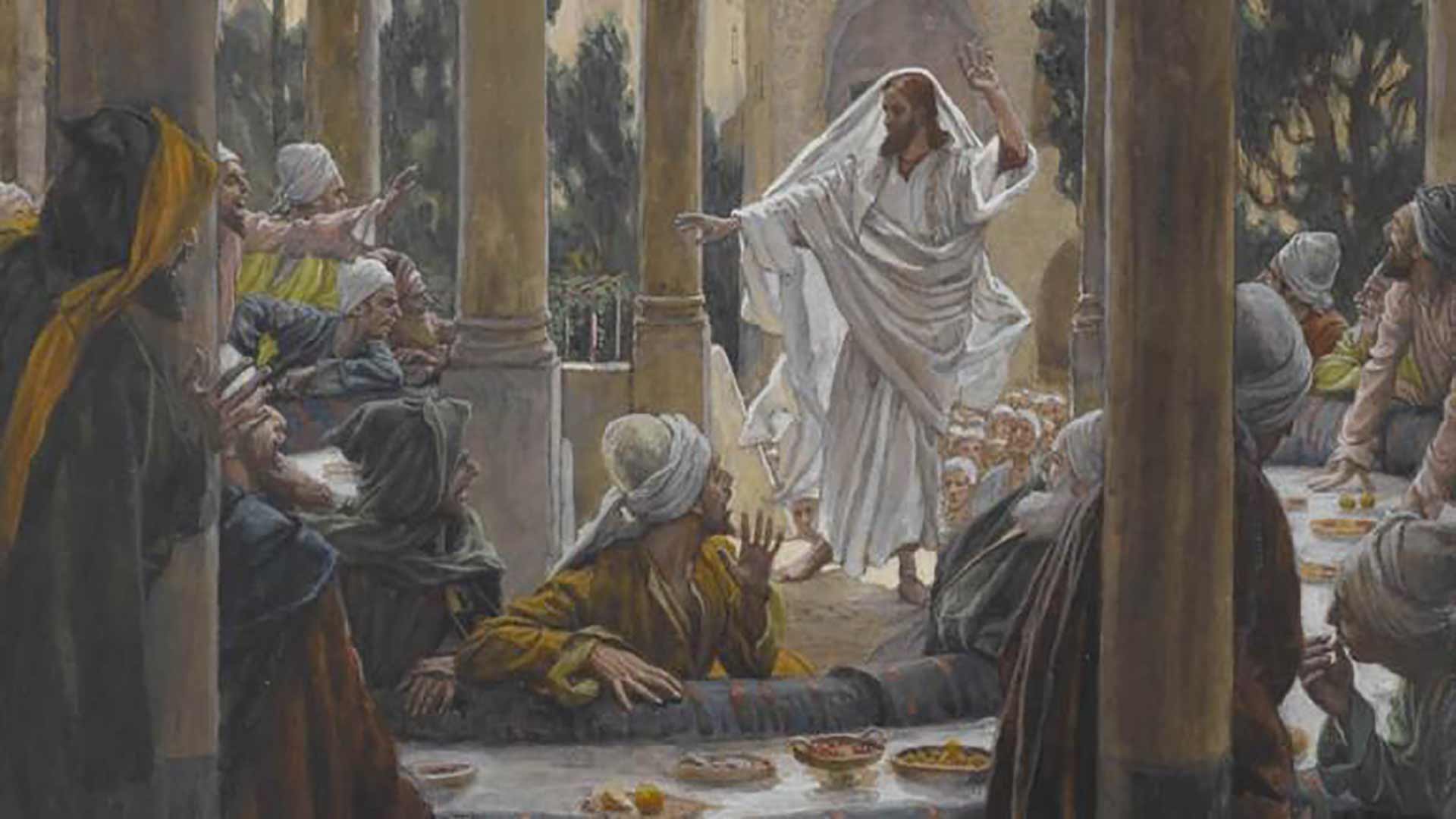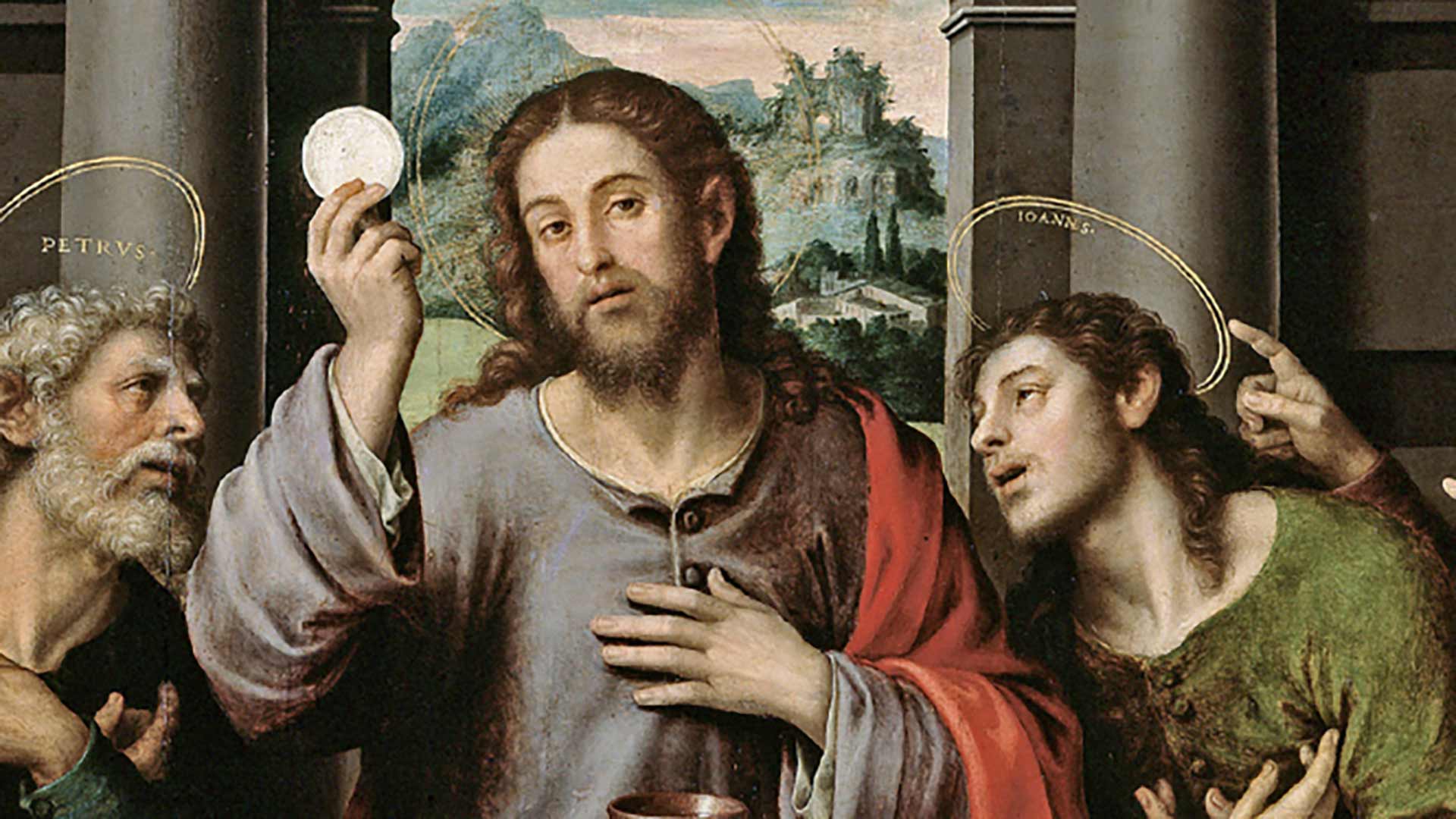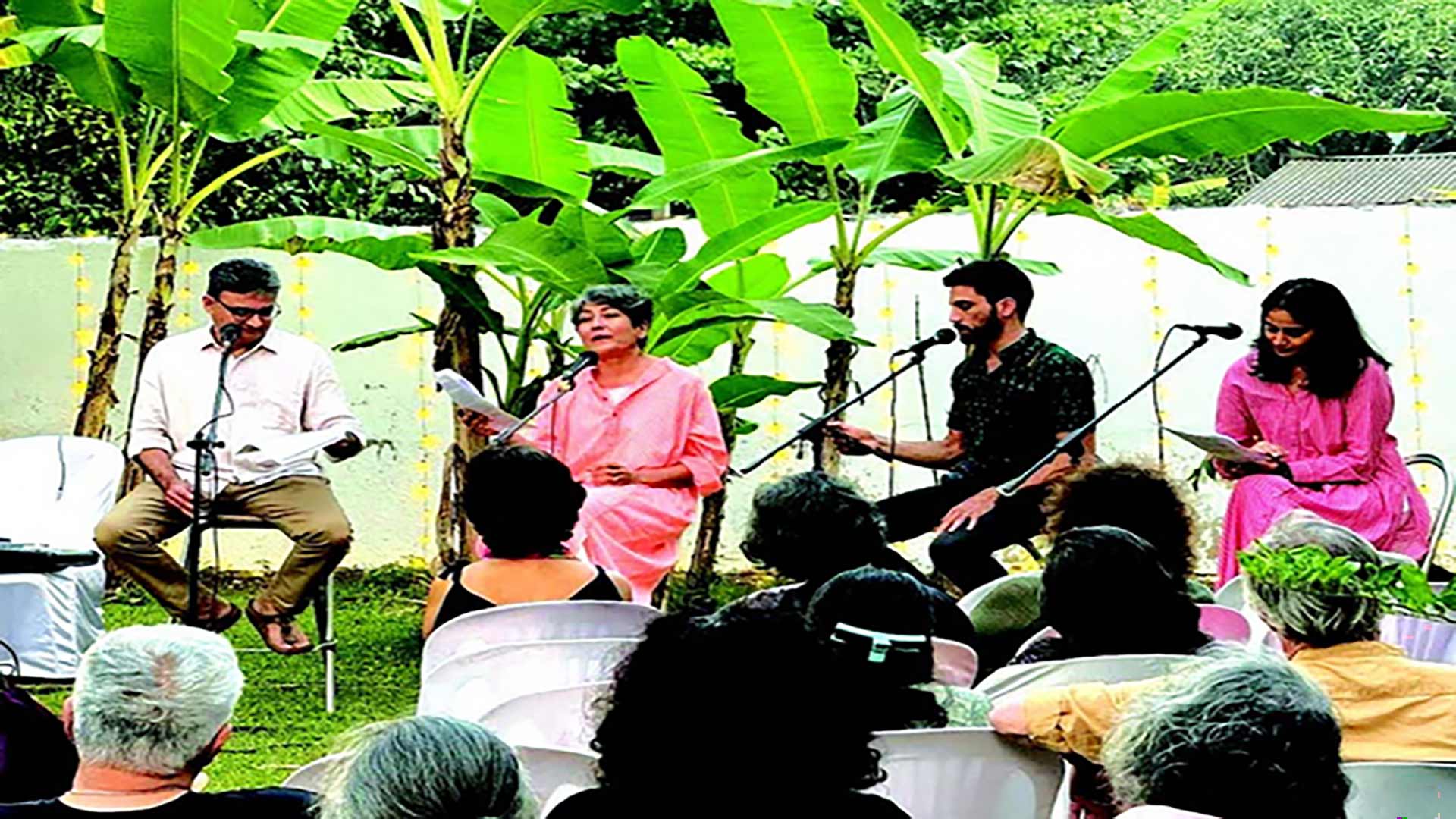In letter and spirit
September 1, 2024Mass Readings
At the end of a week when Our Lord repeatedly rebuked the Scribes and Pharisees – ‘Woe to you, hypocrites’; ‘Woe to you, blind guides’, and so on – and then put before his disciples the delightful imagery of the Bridegroom who arrives at an hour we least expect, and the Master who, on seeing that a servant has squandered the talent, casts him into the outer darkness where men will weep and gnash their teeth; this Sunday we are warmly encouraged to conform to God’s law, which always turns to our moral and spiritual advantage.
But how will such a call be picked up by the contemporary world in which pride and individualism reign, where every one considers themselves to be the law, or above it? Of course, such thoughts seem to arise mostly where God’s law is concerned; human laws – even if illicit or immoral – are followed blindly. We fail to see that, while humans make laws to suit individuals, lobbies, or regimes, God’s laws are above board and apply to both prince and pauper. Yet, we find fault with these – for God is up there, silent, as though inexistent, whereas humans down here are vociferous and exacting...
The First Reading (Deut. 4: 1-2, 6-8) rails against such inversion of principles and values. It highlights the importance of lovingly obeying God’s commandments; keeping them does not make us blind but wise and understanding. None should tinker with the law, reinterpret it, and much less dare to twist it. The Lord is very clear: ‘You shall not add to the word which I command you.’ Integrity should be our watchword. We must seek to follow God’s law in letter and spirit, with sincerity of mind and heart.
The Gospel (Mk 7: 1-8, 14-15, 21-23) clinches it. The Pharisees and the Scribes object to the disciples eating with hands unwashed, foolishly believing they would catch Jesus on the wrong foot. But Our Lord comes down heavily on them, quoting Isaiah, whom the scholars ought to have known: ‘These people honour me with their lips, but their heart is far from me; in vain do they worship me, teaching as doctrines the precepts of men’. Jesus further charged them, saying: ‘You leave the commandment of God, and hold fast the tradition of men.’

Obviously, Jesus had nothing against tradition as long it was in keeping with God’s law – and it did not become the law! In fact, only God and religion can be higher than tradition, which has the unique ability of putting the spotlight on the truth, goodness and beauty of God’s law. Or, as the Second Reading (1 Jam 1: 17-18, 21-22, 27) points out: ‘Every good endowment and every perfect gift is from above, coming down from the Father of lights with whom there is no variation of shadow due to change’ (emphasis ours).
What exalted words that expose the inanities we so often hear: that the Church must ‘move with the times!’ But how? By accepting the false standards of the world, by falling in love with its ways, by falling prostrate to it? Isn’t all of this happening in the name of adaptation, and isn’t that how Christian civilization is being put through a process of paganization? What a far cry from what Pope Leo XIII teaches in Immortale Dei, that wonderful Encyclical on the Christian constitution of States:
‘There was once a time when States were governed by the philosophy of the Gospel. Then it was that the power and divine virtue of Christian wisdom had diffused itself throughout the laws, institutions, and morals of the people, permeating all ranks and relations of civil society. Then, too, the religion instituted by Jesus Christ, established firmly in befitting dignity, flourished everywhere, by the favour of princes and the legitimate protection of magistrates; and Church and State were happily united in concord and friendly interchange of good offices.’[1]
A word to the wise is enough. You can apply the papal concern to the abysmal state of affairs in the countries and continents you live in. In the name of Enlightenment celebrating reason and downplaying faith, the world began rejecting many traditional religious and political ideas that held society together. Under the pretext of secularization, which started with the French Revolution, all -isations flourished, except Christianisation. In the guise of an equal society, some became ‘more equal than others’, and in the name of emancipation, in the May ‘68 civil unrest in France, for example, it was forbidden to forbid!
The world can easily turn topsy-turvy when God is left out of the picture. It is not without reason that St James calls God the ‘Father of lights’ – He is indeed the true Enlightenment! And when Moses called upon his people to be a ‘great nation’ – a model in the sight of the peoples – he was probably referring to Greece, holder of a great artistic and philosophic culture, and to Rome, which enjoyed wide political power. But neither country could hold a candle to Israel, who had ‘a god so near to it as the Lord our God is to us, whenever we call upon Him.’
We are the new chosen people of God. We must ‘receive with meekness the implanted word, which is able to save your souls.’ But we must also ‘be doers of the word, and not hearers only,’ earnestly observing His law in letter and spirit.
[1] https://www.vatican.va/content/leo-xiii/en/encyclicals/documents/hf_l-xiii_enc_01111885_immortale-dei.html
Lord of All History
The First Reading taken from the Book of Joshua and St John’s Gospel text today are well aligned. They impress upon us the supreme concern to worship the One and Only God of History. The Jews were called to do this then; we are to do it now and always.
Joshua was the leader of the Israelite tribes after the death of Moses. He conquered Canaan and distributed its lands to the twelve tribes. His story is told in the Book of Joshua –the sixth book of the Old Testament – which is the story of Israel from the conquest of Canaan to the Babylonian exile.
Realising that he was ‘going the way of all the earth’ (23: 14), Joshua addressed the tribes a second time, at Shechem. He recalled how God had formed their nation and appealed to his people to shun all the false gods that their ancestors had worshipped. The people solemnly promised to worship ‘the Lord our God who brought us and our fathers up from the land of Egypt, out of bondage, and who did those great signs in our sight.’
This is a lesson for all times. Your ancestors and mine who became Christian did so by the grace of God. As Jesus says in the Gospel today (Jn 6: 60-69), ‘No one can come to me unless it is granted him by the Father.’ Our ancestors responded to the call and we, like the Israelites of old, remain eternally grateful. We are also called to remain faithful, to not vacillate but trust in the Lord always. No pagan festival should ever tempt us to break the First Commandment. The Lord our God and Creator of the Universe is the Lord of History. ‘He is before all things, and in Him all things hold together’ (Col 1:15-17).
Coincidentally, while the First Reading is taken from the concluding chapters of the Book of Joshua, the Gospel text is the conclusion of the Bread of Life discourse. Joshua was at the end of his life, and Jesus, ending the second year of His ministry. At this point, many disciples had found the Master’s doctrine a bitter pill to swallow: ‘This is a hard saying; who can listen to it?’ Not paying heed meant not believing that He was the Son of God. No wonder Jesus said, ‘Then what if you were to see the Son of Man ascending where He was before?’
Jesus knew that they hankered after ‘signs.’ And what about us? We tend to think there are fewer miracles today than in the past (when, for sure, there are more miracles than we even get to know of). Anyway, how many ‘signs’ do we need to believe in Him who often cured – and still cures – the humanly incurable; raised to life the dead, and Himself rose on the third day…? Let us not pamper our senses, or test God, by looking for miracles. Let us remember that nothing can surpass the Lord’s Resurrection, which is the bedrock of our faith.
In fact, we must be unreservedly proud of Our Lord who is the Way, the Truth and the Life. His Body and Blood are a guarantee of life eternal. With Him we have everything; without Him, nothing. Hence, when asked if the rest of the disciples too would go the way of other apathetic ones, Peter replied: ‘Lord, to whom shall we go? You have the words of eternal life; and we have believed, and have come to know, that you are the Holy One of God.’ Indeed, ‘it is the spirit that gives life, the flesh is of no avail’; and the words that the Lord our God speaks to us are spirit and life.
Knowing that He would be returning to the Heavenly Father, Our Lord instituted the Holy Eucharist and the Priesthood, besides giving us the commandment of love. He also left us the Church, which is now and forever His visible Body, the visible sign of God’s kingdom on earth. And to Peter, the disciple with the winning answer, he said, ‘You are Peter, and on this rock, I will build my Church” (Mt 16:18). He also called his Church a sheepfold, stating that ‘there shall be one flock, one shepherd’ (Jn 10:16).
However, more pertinent this Sunday is the metaphor of the bride, for St Paul in the Second Reading applies the imagery and symbolism of marriage to Christ and the Church. While the Apostle exhorts wives to be subject to their husbands – ‘for the husband is the head of the wife as Christ is the head of the Church, His Body, and is Himself its Saviour’ – he more importantly commands us believers, who are the Church, to be subject to Our Lord the Bridegroom.
The secular world may not care much for what is to come, just as much as the ‘wisdom of the world is foolishness in the sight of God’ (1 Cor 3: 19). It behoves us, then, to never stop loving Christ and the Church. We must enjoy a holy pride in the now bicentennial and eternal institution. Whereas the world grudgingly recognises her role in the formation of civilisations, and even attempts to pull the rug from under her feet, we Christians must cling to the central figure in all of history. For, as Pope Benedict XVI once put it, ‘the fate of history, our fate, depends on one individual: Jesus of Nazareth.’ He is indeed the Lord of all History.
Konkani is not a dialect of Marathi - 7
Part 7 of "O concani não é dialecto do marata – VII", by Mgr. Sebastião Rodolfo Dalgado (1855-1922)
Published in Heraldo, Vol. IX, No. 2575, 18 February 1917, p. 1
Translated from the Portuguese by Óscar de Noronha and published in
Revista da Casa de Goa, Series II, No. 29, July-August 2024, pp 29-31
Lepechyâ mâthyâr thâpunk: there is no dirt that does not spread over the flounder’s head. This is said in Goa, ‘in my language’, which my mother (may she rest in peace!) has taught me, even it is not that of other Goans perhaps westernised by Marathism; when unwarranted faults are constantly imputed. The reason for the simile is beside the point. For such has been the fate of Konkani. No evil has been left unattributed to it in print and with a professorial air. Not even Mohamed has so viciously bad-mouthed bacon.
Do you not see, then, that the place is swarming mushroom-like with learned men, who state that in Konkani one cannot express abstract ideas? But what do they mean by ‘abstract ideas’? If only we could use more of concrete rather than abstract language; we would have made much progress in practical life. Too much of abstractionism is what is destroying the Indians. The present times are not conducive to nebulous metaphysics and abstruse abstractions. The Europeans, without tigritude (vyaghratā) and other such abstractions, provide us with laws and lessons.
But is it true that the spoken language of the Goan Christians has not a word to denote abstract ideas? And the current and past preachings, do they only deal with concrete things about the cult of linga, yoni, xaxti, Betalla, king cobra? And so many manuals and devotionals, besides books and newspapers that are published, especially in Bombay, don't they contain abstract ideas?
And the Christian catechism? Surely, that's not Marathi. A philological authority has already stated that pottárth, alpabhojan, sadaiv, and other such terms do not exist in Marathi and Sanskrit or do not have the connotations that we assign them. Now, the catechism has hundreds of words like those to designate dogmas and mysteries, virtues and vices, gifts and fruits of the Holy Spirit, dispositions for the sacraments, etc. Are they all concrete words?
Hence, I would have liked to be in Goa and at a public contest see who has abstract ideas, whether a Christian lad with just the knowledge of the Konkani catechism, or a Hindu lad, of the same age, with wide knowledge of Marathi. I do not for a moment hesitate to say that the Christian would carry off the palm.
The reason is obvious to those who know what generally professed Hinduism is. It is in essence more elastic than rubber. That is why it does not have a catechism, a code of doctrines and precepts. Ask a cultured Hindu to state in a few words what he should believe and practice in accordance with his religion, and see the result. It would not be the same with a Buddhist or a Jain. An orthodox Hindu is he who accepts the Vedas in theory, even if he has not seen them, and caste distinctions in practice, even if he cannot explain himself. The rest hardly matters. Philosophers and theosophists have mercilessly rattled the Vedas with their doctrines, but did not openly repudiate them. And that was enough.
If, to express abstract ideas, the Marathists constantly turn to Sanskrit vocabulary, does not Konkani have the same right? Or is Sanskrit the monopoly of the Bhonsles, and no other can touch it? European languages have equal right at least to Greek and Latin, even though they are not all their children; and they do not hesitate to exercise it. How abstract and distracting we can get!
Bread of Wisdom
This Sunday, the Readings and the Psalm focus on wisdom. We get to see how worldly wisdom is no wisdom at all, and how divine wisdom has provided food for thought since times immemorial.
In the First Reading (Prov. 9: 1-6), wisdom is personified by a woman who has built her house on seven pillars. She gears up for the inauguration by slaughtering her animals and mixing her wine. (‘Mixing’, because with the process of distillation still unknown, the potency of wine was increased by the addition of herbs and spices). After she has set her table, she sends out her maids to call the meek and humble of heart to partake of her bread and wine. Whereas she has invited ‘whoever is simple’, she exhorts whoever is ‘without sense’ to walk in the way of wisdom. That is to say, one is expected to be simple, but never naïve.
The Psalm (33: 2-3, 20: 11-15) reminds us that the wise bless the Lord at all times, give him glory and praise. The humble are always happy to hear about God; they revere Him and the saints and feel blessed. The Lord calls us his ‘children’ and also counsels us to live devoutly, guarding our tongue and lips from falsehood. He lets us in on this secret of a long and happy life, which, alas, only the wise understand. We are told that it is not enough to shun evil but also proactively seek to do good. And, even while we engage in war to defend truth and justice, we must continually strive after peace: a lesson that only the truly wise imbibe.
In the Second Reading (Eph 5: 15-20), St Paul too exhorts us to tread life’s path wisely. This involves keeping good company and never wasting one’s time. Of course, understanding the will of God is the touchstone. The Apostle to the Gentiles views wine and song with scepticism, for both tend to slacken the will and cause reason to falter. He therefore recommends that talking and feasting be focussed on the Lord. Finally, the aim is to extol Him and at all times to give Him thanks.
To achieve the goal of a proper moral formation, the Angelic Doctor St Thomas of Aquinas points to the theological virtues – faith, hope, and charity. While they all happen through union with God, it is through charity, or love, that our will and faculties are aligned to the supernatural end. Our life’s efforts are a waste of time if we do not cultivate the virtues; in fact, everything is futile unless centred on God. And once God becomes the alpha and omega, the cardinal virtues of temperance, fortitude, prudence and justice come into play. Temperance and fortitude moderate the passions; prudence enlightens reason, and justice regulates the will.
That may seem like a roadmap to virtuous Christian living, yet it is not enough. ‘A virtue is a habitual and firm disposition to do the good’ (CCC 1803) but it is carried forward not by itself but by the gifts of the Holy Spirit: wisdom, understanding, counsel, fortitude, knowledge, piety, and fear of the Lord (cf. CCC 1830-1831). And sustaining it all is the Holy Eucharist, rightly called ‘the source and summit of the Christian life’ (CCC, 1324). Herein we encounter the bread which Jesus has given ‘for the life of the world’ and so, ought to occupy a central place in our day-to-day life.
From the Gospel text (Jn 6: 51-58), the fourth instalment of the Bread of Life discourse, we know how many Jews abhorred Our Lord’s teaching on his Body and Blood. On the other hand, much that is said about the Eucharist may now seem obvious to us, for we have been taught that the Sacrament is Our Lord’s redemptive Sacrifice at Calvary; that the Bread is Our Lord’s Body and the Wine is His Blood; that Jesus’s presence therein is real, and that partaking of it is a sure means of growing closer to Him. But then, have we had the opportunity to systematically reflect and internalise the doctrine? This is of the essence.
In conclusion, while a little beyond today’s text from the Book of Proverbs, a contrast is established between a wise lady and a foolish woman; and the Second Reading juxtaposes the sagacity of Christian life with the stupidity of godless living, the Gospel effectively draws our attention to the wisdom of Our Lord’s words – ‘I am the living bread that came down from heaven; if any one eats of this bread, he will live for ever’ – vis-à-vis the world’s reckless materialism. The saving grace is that wisdom has come to us in the Incarnation of the eternal Word of God, Jesus Christ Our Lord.
Banner: https://rb.gy/py45eb
Goencheo Mhonn’neo - VIII | Adágios Goeses - VIII
August 14, 2024Sayings and Proverbs,Goan Literature
Segue uma oitava lista de adágios,[1] extraídos do livro Enfiada de Anexins Goeses, obra bilíngue (concani-português), de Roque Bernardo Barreto Miranda (1872-1935)[2].
Concani | Tradução literal | Tradução livre
Unn dudatçó gôntt guilunk nuzó, ani bayrui galunk nuzó. | Hun dudhacho ghontt gillunk nozo, ani bhairui ghalunk nozo.
Um gole de leite quente,
(tomado sem reflectir,)
não se sabe se o deve
deitar fora ou engolir.
Há muitas vezes embaraços
que metem em tal situação,
que não se sabe, no momento,
como sair da entalação.
Variante
Quando alguém é dependente
de dois rivais, em questão,
fica indeciso p’ra dar
Sua franca opinião.
Kaddi báil ghovachi, gori báil povachi.[3] | Kalli bail ghovachi, gori bail povachi.
A mulher preta é
do esposo somente.
mas a mulher clara
é de toda a gente.
A mulher feia é só do homem,
com quem está desposada,
mas sendo a mulher bonita,
é por todos requestada.
-o-o-o-o-
[1] Cf. sétima lista, Revista da Casa de Goa, Série II, No. 27, março-abril de 2024, p. 47.
[2] Roque Bernardo Barreto Miranda, Enfiada de Anexins Goeses, dos mais correntes (Goa: Imprensa Nacional, 1931), com acrescentamento dos adágios na grafia moderna, pelo nosso editor associado Óscar de Noronha.
[3] ‘Povachi’ = do povo.
(In Revista da Casa de Goa, Serie II, No. 29, Julho-Agosto 2024, p. 51)
Bread and Faith
Today’s Readings are yet another affirmation of our ancestors’ faith and trust in the Lord’s never-failing love and care. He is indeed a Provider par excellence; He sustains us, and never lets us down. May generations believe that He is our everything, and nothing shall we want!
In the First Reading (1 Kings 19: 4-8), the Prophet Elijah, threatened by king Ahab and queen Jezebel, feels forsaken and desperate. He goes into exile and, when exhausted from walking no end, sits under a broom tree, crying, ‘It is enough; now, O Lord, take away my life.’ He would have readily died in the desert where his ancestors had wandered for forty years; but God had a different plan. The angel of the Lord urged him to rise, feed himself and get going. The prophet then went to mount Horeb (also called Sinai), where he spent forty days and forty nights.
They say, man proposes; God disposes. Elijah’s cry ‘Satis est, Domine, satis est,’ was also the cry of so many holy men after him, including our own St Francis Xavier. But then, God turned the situation to Elijah’s advantage. The prophet felt spiritually renewed on God’s mount. That was the soil that his ancestors had stepped on and were given the Torah, of which Elijah was presently the depositary and interpreter. It was the site where God had appeared to Moses; and Elijah was now defending the principles of the Mosaic Covenant, against the prophets of Baal, who were on the royal payroll.
In the Gospel (Jn 6: 41-51) we have the New Testament counterpart of several episodes of the Old Testament. The Bread of Life discourse that began on the seventeenth Sunday of this year is now in its third instalment. Today, we hear Jesus say, ‘I am the Bread which came down from heaven.’ The message that the angel gave Elijah a millennium earlier is now perfected. Truly, ‘the grass withers, the flower fades, but the word of our God will stand forever’ (Is 40: 8).
Picking up from we left off last Sunday, we know from today’s Gospel text that the Jews murmured at Jesus, because of His unprecedented claims. They checked His credentials – ‘Is not this Jesus, the son of Joseph, whose father and mother we know…’? – but somehow, they failed to discern His divine origin. Jesus, the Son of God, did not stop to placate the people but went ahead and reiterated His message, saying: ‘No one can come to Me unless the Father who sent Me draws him; and I will raise him up on the last day.’
Jesus wanted to let the people know that they needed a special grace to come to Him. It was not a privilege that they could bestow upon themselves; rather, God had to favour them with the required grace. It did not come easy. Hence, Jesus did not labour the point but rather restated it very categorically: ‘I am the Living Bread which came down from heaven; if any one eats of this bread, he will live for ever.’
The Living Bread is not our everyday physical bread, which anyway cannot sustain us; it is spiritual bread that is life-giving… Next Sunday, Jesus will go a step further and explain that, really speaking, the bread He gives for the life of the world is His flesh. This is not a message for the faint-hearted but for those who have total faith and trust in the True God. It preannounces the institution of the Holy Eucharist – that ineffable Sacrament in which Our Lord gives Himself to us as the heavenly Food and Drink.
We Catholics must consider ourselves extremely privileged and thankfully share in such an exalted Mystery. We who have been thus ‘sealed for the day of redemption’ ought not to disappoint the Holy Spirit of God. In fact, in preparation for that day, St Paul in the Second Reading (Eph 4: 30; 5: 2) exhorts us to give up all bitterness, wrath, clamour, slander, malice; and to be kind, tender-hearted, forgiving and imitators of God. Finally, he says, we must ‘walk in love, as Christ loved us and gave Himself up for us, a fragrant offering and sacrifice to God.’
Does that smack of weakness? Not at all. And what Jesus said to St Paul, He says to us today: ‘My grace is sufficient for you, for my power is made perfect in weakness’ (2 Cor 12: 9-11). All that we need to do is to believe in the Real Presence of the Body and Blood, Soul and Divinity of our Lord Jesus Christ in the Holy Eucharist. Lo and behold, He who ‘died’ two millennia ago is still the Living Bread. He is alive!... And our faith, how alive is it?
Banner: https://rb.gy/xgxi7l
Bread from Heaven
The Holy Eucharist we receive is bread that first came down from Heaven in Moses’ time. The bread God sent down promptly established a bridge between heaven and earth. It was renewed by Jesus, who was Himself the Bread of Life. Why, then, settle for anything less?
In the First Reading (Exod. 16: 2-4, 12-15), Moses finds himself at the crossroads. He has done all he can for his people, risking his life to free them. He answered God’s call, but alas, drew fire from ungrateful Israelites. They began to long for the fleshpots of Egypt, which they had left behind for a higher good – their freedom as a people of God.
But God did not give up on them. He did all that was necessary to show His love. At twilight He gave them flesh, and in the morning bread: at dusk, quails came up and covered the camp, and at dawn, manna, a flake-like thing fine as hoarfrost. Interestingly, manna was meant for a day, thus prefiguring ‘our daily bread’! So, what more could one ask for? The Israelites had food for the body and God’s Word for the soul. Yet, they did not stop muttering in discontent.
In a passage that closely parallels that Old Testament text, we read in the Gospel (Jn 6: 24-35) that the people pursued Jesus. Our Lord knew that they sought Him not for the spiritual bread of His teachings but for the physical bread to satisfy their hunger. Earlier on, He had fed the multitude, and now He’d rather they hungered for the Bread of Life.
The passage of St John the Evangelist, quoted above, is part of the ‘Bread of Life discourse’: Jesus offering His Body and Blood as food and drink. He is the Living Bread, which we now receive in the Holy Eucharist. Many have lived on the Holy Eucharist alone (as seen from the list below).[1]
Can we survive in like manner? Or rather, would we wish to do so? No doubt, it’s perfectly legitimate to enjoy the good things of this earth, including the pleasures of the palate – our senses are attuned to them, aren’t they? However, many mystics and saints had a higher calling and level of perfection. They turned their eyes heavenward for the Bread of Life. And obviously, like them, we ordinary mortals, too, when in a state of grace, are conceded all the merits of the Holy Eucharist.
It is then very important for a Catholic to know what is meant by the Body and Blood of Christ and the spiritual benefits derived. It is literally, not metaphorically, the Body and Blood of Christ that we consume. Some of those who had heard Jesus talk of his Body and Blood were sickened and terrified by the suggestion; they left his company and returned to their old ways.
What about us? Sometimes, we too receive the Eucharist quite routinely, hardly pondering the ineffable mystery.
Today on the feast day of St Jean-Marie Vianney (1786-1859), we may ask: are we actively promoting the most Catholic belief of the Real Presence of God in the Blessed Sacrament? The Patron Saint of Parish Priests, who valued the Transubstantiation taking place at every Holy Sacrifice of the Mass, said: ‘Holy Communion and the Holy Sacrifice of the Mass are the two most efficacious actions to obtain the conversion of hearts.’
The Holy Mass and Communion thus lend purpose, meaning, and direction to Catholic living. Behold the orderliness and transcendent beauty of the Holy Mass and Communion at Christ's Table, in stark contrast with sinful orgies and bacchanalia of the past and present. Christ changed it, once and for all, giving the world new life, new hope. There is no looking back.
Those who receive new life in Christ cannot bear to think of relapsing into their former ways. Hence, St Paul in the Second Reading (Eph 4: 17, 20-24) urged his followers to no longer live ‘in the futility of their minds.’ He called upon them to give up their old nature and all that was corrupt through deceitful lusts, and be renewed in the spirit of their minds. And the same applies to us today.
We are a most favoured lot, and ought to be most thankful for the same. St Thomas Aquinas’ in his hymn ‘Panis Angelicus’ is all praise for the res mirabilis, the miraculous thing, of the bread of angels becoming the bread of men! Why, then, settle for anything less?
[1] The Italian saints, Franciscan tertiary Angela of Foligno (1248-1309) and mystic Catherine of Siena (1347-1380); Dutch mystic St Lidwina of Holland (1380–1433); Swiss hermit St Nicholas of Flue (1417-1487); Italian friar and mystic St Joseph of Cupertino (1603-1663); Augustinian canoness St Anne Catherine Emmerich (1774-1824); Portuguese mystic and victim soul Alexandrina Maria da Costa (1904-1955); German mystic St Thérèse Neumann (1898-1962), and more recently, the Brazilian laywoman, now Servant of God, Floripes de Jesus (1913-1999)
Paris perece...
July 28, 2024Revolucao Francesa,Jogos Olimpicos,Paris,Carlos Magno,Ultima Ceia parodiadaReflexão dominical
Não podemos imaginar escassez neste mundo moderno de abundância. Muitas vezes, as gerações mais novas admiram a forma como os seus antepassados viveram com recursos limitados e ainda assim chegam a recordar os velhos tempos com ternura. É que eles viviam com fé ou, pelo menos, não ofendiam Deus. Seria errado infligir dor ao Eterno Provedor. Enquanto Ele dá alegria aos que nele creem, os que acreditam em si próprios e se divertem noite e dia acabam por não ver a luz ao fundo do túnel.
As leituras de hoje convidam-nos a confiar muito especialmente na Divina Providência, independentemente das circunstâncias. A Primeira Leitura (2 Reis 4: 42-44) mostra-nos como Eliseu, com apenas vinte pães de cevada, alimentou cem esfomeados. Era a promessa do Senhor, cumprida depois de o profeta lhe ter manifestado a sua total devoção. E o milagre simboliza o facto de nada ser impossível a Deus: Ele conhece e satisfaz todas as nossas necessidades e, sobretudo, as espirituais, dos que anseiam pela Palavra de Deus.
Embora sempre a leitura do Antigo Testamento se encontre coordenada tematicamente com o texto do Evangelho, neste domingo essa ligação fica claríssima. Ambas as leituras falam da multiplicação dos pães. Do Antigo Testamento vemos como Deus dá pão aos israelitas que passam fome no deserto (Ex 16: 4) e como Elias cria uma fonte inesgotável de farinha e de azeite para sobreviver à fome (Reis 17: 15-16); mas nem um nem outro desses exemplos se assemelha à história do Evangelho de hoje (Jo 6: 1-15).
Relatos evangélicos
Há seis relatos evangélicos sobre a multiplicação dos pães. Jesus alimentou duas vezes o povo – de uma vez, 5.000 comeram de cinco pães e dois peixes, e sobraram doze cestos daqueles; e noutra ocasião, 4.000, com sete pães e alguns peixes, e sobraram cinco cestos. Aquele é o único milagre (para além da Ressurreição) que se encontra registado nos quatro Evangelhos; e apenas Mateus e Marcos, sob pena de repetição, registaram ainda o segundo.
Este milagre realça a sensatez de uma abordagem sobrenatural, mesmo quando se trata das nossas necessidades materiais. É da essência confiar no Senhor, que disse: “Não vos preocupeis, dizendo: ‘Que comeremos, que beberemos, ou que vestiremos? Os pagãos, esses sim, afadigam-se com tais coisas; porém, o vosso Pai celeste bem sabe que tendes necessidade de tudo isso. Procurai primeiro o Reino de Deus e a Sua justiça, e tudo o mais se vos dará por acréscimo. Não vos preocupeis, portanto, com o dia de amanhã, pois o dia de amanhã já terá as suas preocupações. Basta a cada dia o seu problema. (Mt 6: 31-34).
É claro que todos os nossos problemas terminam à Mesa da derradeira refeição que Jesus nos ofereceu: a Sagrada Eucaristia. Isto acontece em cada Sacrifício da Missa. A multiplicação dos pães prefigurava o exemplo supremo de amor de Nosso Divino Senhor e Mestre, instituído na Última Ceia. Por isso, foi muito doloroso ver tudo isso parodiado na cerimónia de abertura dos Jogos Olímpicos em Paris na última sexta-feira.
Pouco importa que o desfile tenha sido fora do contexto do desporto; e seria um eufemismo dizer que ele foi de mau gosto. A vaidade em desfile traiu a memória de Carlos Magno e foi uma afronta à religião que moldou a França. O rei dos Francos, que se esforçou pela união dos povos cristãos, foi considerado o “Pai da Europa”, e o seu país chamado a “filha mais velha da Igreja Católica”. Assim, o que se passou em França no dia da semana em que Cristo morreu é nada mais nada menos do que pecado nacional que clama aos céus por vingança.
Paris ou perecimento?
A unidade da Europa cristã, tão desejada por Carlos Magno, foi uma reprodução fiel do que São Paulo, séculos antes, havia querido em relação à Igreja. Na Segunda Leitura (Ef 4: 1-6), o Apóstolo dos Gentios implora ao seu povo que leve uma vida digna da sua vocação: “Existe uma só esperança na vida a que fostes chamados. Há um único Senhor, uma única fé, um único baptismo. Há um só Deus e Pai de todos, que está acima de todos, actua em todos e em todos se encontra”. Sim, em nós e em França. Infelizmente, a nossa reacção foi pobre, trágica, e as consequências não podem ser diferentes; é uma questão de justiça sobrenatural....
No entanto, quaisquer que sejam os problemas que enfrentamos, individualmente, como nação ou como civilização, eles nunca são demasiado grandes para Deus. Assim, quando multiplicamos os problemas, Deus multiplica as soluções; quando multiplicamos as maldições, Ele multiplica os julgamentos; e ainda, quando multiplicamos as orações, Deus multiplica as bênçãos. Igualmente oportuno é notar o lema de Carlos Magno: In Scelus Exsurgo Sceleris Discrimina Purgo (“Luto contra a agressão e castigo o agressor”).
A paródia parisiense é a Revolução Francesa em modo loop. A revolução continua, destinada contra a Igreja Católica. Todas a reconhecem, menos os católicos! Somos talvez os únicos que gozam livremente com a própria Mãe, a Igreja. Quem se atreveria a tentar estas palhaçadas contra outras religiões? Devemos perdoar mesmo quando a nossa Mãe está a ser atacada? Já nada é sagrado?
Será que Roma e a Igreja em França e em todo o mundo vão então condenar formalmente esta situação? E tu e eu? Será que vamos aceitar estupidamente, mais uma vez, que o inimigo tem razão e que só nos resta dizer “Touché”?
Banner: https://rb.gy/r69d67
Paris and Pain
July 28, 2024Last Supper parody,Olympic Games,Last Supper,Last Supper mocked at,Paris OlympicsMass Readings
Scarcity is all but unimaginable in our modern world of plenty. Younger generations often wonder how their ancestors lived with limited resources and yet can recollect the old days with tenderness. For one thing, they lived by faith, or at least did not blatantly offend God. It would be wrong to repay the Eternal Provider of our pain quotidien (daily bread) with pain. Whereas He cheers those who believe in Him, those who believe in themselves and revel in the sunshine eventually see no light at the end of the tunnel.
Today’s Readings invite us to trust in Divine Providence very especially, regardless of the circumstances. The First Reading (2 Kings 4: 42-44) shows us how Elisha, with just twenty loaves of barley, fed a hundred hungry men. It was the Lord’s promise, fulfilled after the Prophet had manifested his total devotion to Him. And the miracle is symbolic of how nothing is impossible with God: He knows and satisfies our every need and, above all, the spiritual needs of those who hunger for His Word.
While every Sunday, the Old Testament reading is coordinated thematically with the Gospel text, the connection this time around is more than obvious. Both readings are about multiplication of loaves. In the Old Testament there are examples of God providing the Israelites with bread as they starved in the wilderness (Ex 16: 4) and Elijah creating an unending supply of flour and oil so as to survive a famine (Kings 17: 15-16), but neither parallels today’s Gospel story as strongly.
Four Gospel accounts
There are six Gospel accounts of the multiplication of loaves.[i] Jesus twice fed the people — once, 5,000 were fed with just five loaves and two fish, and twelve baskets of bread were left over; and on another occasion, 4,000, with seven loaves and some fish, and they had five baskets remaining. The former miracle is the only one (other than the Resurrection) that is recorded in the four Gospels; only Matthew and Mark, even if repetitiously, made a note of the second instance as well.
The miracle highlights the wisdom of having a supernatural approach even in what concerns our material needs. Trusting in the Lord is of the essence, for He has said, ‘Do not worry, saying, ‘What shall we eat?’ or ‘What shall we drink?’ or ‘What shall we wear?’ For the pagans run after all these things, and your heavenly Father knows that you need them. But seek first His kingdom and His righteousness, and all these things will be given to you as well. Therefore, do not worry about tomorrow, for tomorrow will worry about itself. Each day has enough trouble of its own.’ (Mt 6: 31-34)
Of course, all of our troubles end when we partake of the ultimate meal that Jesus has provided us with: the Holy Eucharist. This happens at every Sacrifice of the Mass. The multiplication of loaves foreshadowed Our Divine Lord and Master’s supreme example of love instituted at the Last Supper. It was therefore very painful to see it all parodied at the opening ceremony of the Olympic Games in Paris on Friday.
That the tableau was hardly contextual is beside the point; that it was in bad taste is an understatement. The vanity on display was but a betrayal of the memory of Charlemagne and a direct affront to the religion that has shaped France. The king of the Franks, by his efforts to ensure the unity of Christendom, was regarded as ‘Father of Europe’, while his country was called the ‘eldest daughter of the Catholic Church’. So, what happened in France on the weekday of Christ’s death is nothing short of a national sin crying out to heaven for vengeance.
Paris or perish?
Charlemagne’s much-desired unity of Christian Europe was a faithful reproduction of what St Paul, centuries earlier, had strived for with respect to the Church. In the Second Reading (Eph 4: 1-6), the Apostle to the Gentiles begged of his people to lead a life worthy of their calling: ‘You were called to the one hope that belongs to your call, one Lord, one faith, one baptism, one God and Father of us all, who is above all and through all and in all.’ We are; France is. But alas, our response has been pathetic, tragic, so the consequences may not be any different; it is a matter of supernatural justice…
Yet, whatever the problems facing us, individually, as a nation or as a civilisation, they are never too large for God. For example, when we multiply problems, God multiplies solutions; when we multiply curses, He multiplies judgements; and yet, when we multiply prayers, God multiplies blessings. It is equally apt to note Charlemagne’s motto: In Scelus Exsurgo Sceleris Discrimina Purgo (‘I fight against aggression and punish the aggressor’).
The ongoing Parisian mockery is French Revolution in loop mode. The revolution is still on, and it is against the Catholic Church. Alas, all but the Catholics seem to recognise it! We are perhaps the only ones who freely mock our own Mother, the Church. None would dare try these antics against any other religion... Are we to forgive even when our Mother is under attack? Is nothing sacred anymore?
Will Rome, then, and the Church in France and the world over, come out with a formal condemnation? And what about you and me? Are we going to foolishly accept, yet again, that the enemy is right, so all that is left to do is say Touché?
[i] Mt 14: 15-21 and 15:32-39; Mk 6: 35-44 and 8: 1-9; Lk 9: 12-17; Jn 6: 1-13
Banner: https://rb.gy/r69d67
De falea, feni e pugnar por Goa
July 24, 2024TraduçãoTradução,Cultura Goesa
Uma conversa de Brian de Souza com Michelle Mendonça Bambawale, sobre como o escrever Becoming Goan (Ser Goês) a consumiu. Tradução de Oscar de Noronha, publicada, junto com o original, na Revista da Casa de Goa, No. 29, Julho-Agosto de 2024, pp. 32-36. https://online.fliphtml5.com/bcbho/kehk/?1720968246254#p=14
Encontramo-nos pouco depois das 16h, no Caravela, um café no bairro de São Tomé, em Pangim. É uma tarde abafada de sexta-feira. Depois de mandar vir chá e panqueca de laranja, começámos a falar sobre o livro Becoming Goan, de Michelle.
É o seu primeiro livro, muito íntimo, lançado nos princípios deste ano, após o qual Michelle empreendeu uma digressão promocional “auto-infligida”. O livro vai bem, disse, e está esgotada a primeira tiragem de 2.000 exemplares. Assinou os direitos para a venda do livro internacionalmente; e está muito entusiasmada, pois isso vai permitir a compra do livro não só aos goeses da diáspora, mas também aos outros que visitaram e desejam saber mais sobre o pequeno estado de Goa.
Começo por perguntar o que a levou a escrever esse livro. “Andava a blogar durante a Covid e escrevi Being Goan, que era sobre o que há de tão especial nos goeses, (e isso mais tarde entra como capítulo no presente livro), e Living in Siolim in 2020, sobre como as coisas haviam mudado: a comida, as pessoas, etc. E porque tanto ela como Goa estavam a mudar, Michelle sentiu-se inspirada: era “o único livro que queria escrever”.
Becoming Goan é uma narrativa diversificada. Tem memórias, histórias pessoais, tradições socioculturais, curiosidades e lendas, a terra e o feni (bebida fermentada, única de Goa), e mais. Quando peço a Michelle que fale da essência da obra, diz que surgiu como um livro sobre “os dias da minha vida”, como uma placa de Petri em que “queria capturar somente as minhas vivências”.
Foi-lhe dito que os acontecimentos da sua aldeia ancestral de Siolim tinham paralelos com Shimla ou Kerala; mas para ela, Goa é única, a sua “cultura é diferente”. Por ironia do destino, os seus avós haviam partido para Pune, na Índia Britânica, em busca de oportunidades, porém, décadas depois, Michelle voltava, passando a viver em Siolim, pois, entretanto, o mundo já era outro.
Goa sincrética
Contextualiza o livro, dizendo: “Sempre fui indiana e, com o livro, adicionei um ingrediente goês à minha identidade indiana”. E acrescenta com naturalidade: “Não conhecia a Goa sincrética”. Aqui aponta um tema que é sem dúvida o substrato do livro: a identidade. As questões de identidade estão a ser debatidas globalmente, e isso “me fez pensar sobre a minha cultura; e tendo passado uma vida inteira no ramo da educação, era um tema constantemente abordado, no que diz respeito à língua materna, à cultura e às questões à volta do colonialismo e do preconceito ocidental, etc.”
As apresentações do livro já a levaram a Mumbai, Pune e Bengaluru, onde amigos, familiares e ex-colegas apareceram com entusiasmo para a ouvir ler o livro e responder a perguntas. E em Dubai, foi entrevistada pelos apresentadores do podcast “Kiss me, I’m Goan”.
Será que Goa é vista como não-convencional em relação à grande tela indiana? Diz Michelle: “Muitos disseram-me que quando vêm a Goa, podem livrar-se do salwar kameez, pois a cultura é de aceitação”. Afinal, os goeses, tanto cristãos como hindus, são conservadores, mas os de fora vêem a identidade goesa como essencialmente “hippie”.
Falando de aspectos da identidade, Michelle admite que tem dificuldades com o concani, embora ache a versão hindu mais fácil por estar mais próxima do marata, que conhece. À parte da língua, os elementos da identidade goesa incluem a religião sincrética, a dependência do arroz, do coco e do peixe, algo que, quem aqui vem, não compreende. Ela fica triste por quem mora no estrangeiro ou vem de outros lugares da Índia, tentando aqui “recriar o seu Dubai ou Delhi”, não se integrar na cultura local.

Falea
De seguida, conversamos sobre certos aspectos do livro, a começar por falea, “amanhã” em concani, ou essencialmente algo que “pode esperar por amanhã”. Michelle atira a cabeça para trás e ri-se. Admite que é frustrante. “Tenho que ir a Mumbai e sentir a urgência no meu sistema”, observa.
Depois, há a buzina e a raiva na estrada. Michelle conta uma anedota sobre a sua visita ao extraidor de óleo de coco. Encontrou aí pessoas sentadas calmamente à espera de que chegasse o dono. Eram apenas aldeões que estavam habituados a esperar sem nunca reclamar. E lá fora, eram as buzinas e o trânsito. Acha que é bom ter paciência, e que não ter pressa é um modo de vida já aceite. Pessoas estranhas ao meio tão-pouco conseguem entender o que se passa.
Encontro com o feni
Falamos sobre o seu encontro com o feni. Michelle novamente atira a cabeça para trás e ri-se. Lembra-se dum dia cansativo quando a urraca com gelo a reanimou. Mas nem por isso gostava muito do feni, até que recentemente a bebida lhe foi recomendada para problemas do estômago. É, portanto, um gosto adquirido. Duas amigas suas que leram o seu livro provaram ou a urraca ou o feni. “Se o feni é parte integrante de Goa, também o é a propriedade rústica”, acrescenta Michelle. Todo o goês tem um problema a resolver ou enfrentar, e isso “faz dele um goês”.
Um tio ilustre
Digo-lhe que me comove o que escreveu sobre o seu tio e padrinho, o comandante de esquadrilha Clarence D’Lima, que morreu em 1977, ao tentar aterrar o avião que tinha a bordo o ex-primeiro-ministro Morarji Desai, que sobreviveu. Relembra as memórias de seu tio, que, na altura, tinha apenas 39 anos. “Era arrojado, e há histórias de como aterrava o seu helicóptero ao pé da sua aldeia de Socorro e corria para casa. Era alvo do culto dos heróis, porém, quando criança, foi travesso: abria autoclismos, descia pelos degraus de casa com a sua bicicleta, fazendo todo o tipo de coisas arriscadas”
Comunidade ameaçada
Com a migração interna e externa de Goa, pergunto se os goeses são uma comunidade em perigo. Observa que, enquanto os goeses se multiplicam lá fora, em Goa passam a ser uma minoria. Tendo obtido passaporte português, muitos optaram por partir, frustrados com a venalidade e a falta de oportunidades.
Michelle elogia os que pugnam por Goa. Cita exemplos de aldeões de Carmonã, Pomburpa e Siolim, os quais lutam por preservar o seu modo de vida: “Os siolenses estão furiosos e exaustos de lutar pelos seus direitos. Essa questão tem que entrar no debate político; as coisas têm que mudar.”
Do balcão da sua casa em Siolim desfruta de boa vista, vê “pessoas não-goesas dispostas a assinar reclamações contra o corte de árvores e a destruição do meio-ambiente. São jovens e velhos, e isso é bom. Quem entrou com acção policial no caso do corte de árvores de Siolim é um jovem que trabalha na diáspora.”
Ao escrever o seu livro, Michelle sentiu influências de vários outros: Filomena e A Daughter's Story, ambos de Maria Aurora Couto; Glad Seasons in Goa, de Frank Simões, o qual está esgotado; bem como o icónico romance goês, Sorrowing Lies my Land, de Lambert Mascarenhas, que foi reeditado em 2022. Além disso, dois romances sobre a diáspora goesa lhe falaram à alma: Gods and Ends, de Lindsay Pereira, passado entre os goeses de Mumbai, e Sunita De Souza Goes to Sydney, and Other Stories, de Roanna Gonsalves. Ambos a fizeram pensar em como as pessoas que saem de Goa não voltam aos seus lugares ancestrais, mesmo que tenham aí propriedades. E leu também Karmelin, de Damodar Mauzó.
Ao encerrarmos o bate-papo, remeto para o epílogo do livro, onde Michelle apela que haja um equilíbrio entre o desenvolvimento e a preservação do ambiente. No fim, cita G. S. Patel, juiz da Relação, que considera Goa como terra pela qual vale a pena lutar: “Citei-o, pois não podia escrever de outra maneira”.
Sejamos ou não ancestralmente goeses, o que importa é lutar pelo que há de precioso em Goa, frisa Michelle. Na sua opinião, todos os que pugnam por Goa são, na realidade, goeses. E assim terminamos com uma nota de esperança. Chega a hora de preservar Goa. Nesse particular, não pode haver “falea”.
Banner: https://rb.gy/6icpqo








